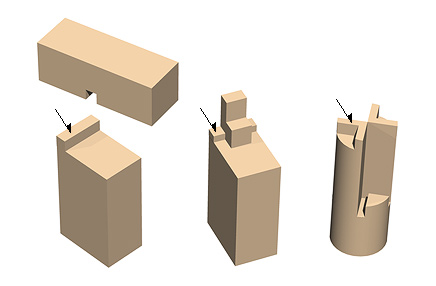| Also
called iriwa όΦ. Lit. a collar ring. A collar tenon. It has a step-like
piece called a collar, cut on each side about two-thirds of the distance
from the tenon to the edge of the beam. The mortise into which the collar
tenon will be attached at right angles is cut from the inner side of a beam.
The matching mortise is called eriwa-ana έΦ (also iriwa-ana
όΦ). Since the two parts are joined together at right angles, this belongs
to the broad category of joinery called *shiguchi
dϋ. This type of tenon is sometimes combined with haunched tenon *konehozo
¬ͺΩΌ, which has a smaller tenon on the tip of a larger one, used especially
when joining wooden parts of mud sills *dodai
yδ in a grid pattern. There are many types of collar joints. One further
example is the eriwa konehozosashi έΦ¬ͺΩΌ·, or collared haunch mortise.
|

